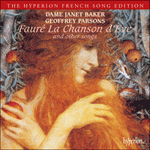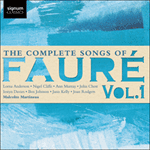The model of this kind of mélodie has already been established by Le secret (1880). The accompaniment (as in so many later Fauré songs) begins in simple crotchets, slightly detached (in this case distant stars a-twinkle – cf
Diane, Séléné from
L’horizon chimérique), seemingly uneventful, yet the epitome of harmonic subtlety. With the gradual arrival of dawn the music builds and develops over four pages. After the rapt diffidence of the first strophe the accompaniment (without a change of pulse) flowers into semiquavers for the second verse in the minor key. At the third strophe (the song is an ABA structure) the semiquavers are re-energized for a triumphant return to the major. With the warmth of a new dawn comes a new romantic confidence. The deployment of notes between the hands (a crotchet in the left, three semiquavers in the right) as well as the key of G major, prophesy the optimistic
N’est-ce pas? from
La bonne chanson. The poem is the fourth in a sequence of eight (entitled
Matutina) from Silvestre’s collection
Le pays des roses. The title ‘Aurore’ is Fauré’s own.
from notes by Graham Johnson © 2005
Le secret (1880) a déjà établi le modèle de ce genre de mélodie. L’accompagnement (comme si souvent dans les mélodies fauréennes ultérieures) commence par de simples noires, légèrement staccato (ici, des étoiles lointaines qui se mettent à scintiller—cf.
Diane, Séléné, extraite de
L’horizon chimérique), apparemment banales, mais qui sont la quintessence de la subtilité harmonique. Avec la venue progressive de l’aube, la musique se construit et se développe sur quatre pages. Après la pudeur extatique de la première strophe, l’accompagnement (sans changement de rythme) s’épanouit en doubles croches pour la deuxième strophe, en mineur. À la troisième strophe (la mélodie présente une structure ABA), les doubles croches sont revitalisées pour un retour triomphant du mode majeur. La chaleur d’une aurore nouvelle s’accompagne d’une nouvelle confiance romantique. Le déploiement des notes partagées aux deux mains (une noire à la gauche, trois doubles croches à la droite), mais aussi la tonalité de sol majeur, préfigurent l’optimiste
N’est-ce pas? de
La bonne chanson.
Aurore est le quatrième poème d’une série de huit textes intitulée
Matutina et tirée du recueil de Silvestre,
Le pays des roses. Le titre est de Fauré.
extrait des notes rédigées par Graham Johnson © 2005
Français: Hypérion


 Fauré: La chanson d'Ève & other songs
Fauré: La chanson d'Ève & other songs Fauré: The Complete Songs, Vol. 1
Fauré: The Complete Songs, Vol. 1
